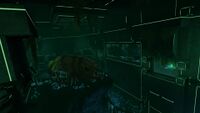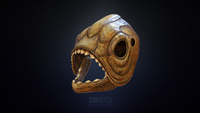Research Specimen: Difference between revisions
GemmaBeepo (talk | contribs) No edit summary |
GemmaBeepo (talk | contribs) No edit summary |
||
| Line 18: | Line 18: | ||
This specimen is distantly related to five species still living on the planet today; the PDA notes shared skeletal traits with the Biter and Sand Shark, by extension this also makes '''Research Specimen Theta''' a relative of the [[Boneshark]] and [[Blighter]], and a very distant relative of the [[Rockgrub]]. |
This specimen is distantly related to five species still living on the planet today; the PDA notes shared skeletal traits with the Biter and Sand Shark, by extension this also makes '''Research Specimen Theta''' a relative of the [[Boneshark]] and [[Blighter]], and a very distant relative of the [[Rockgrub]]. |
||
The forearms are unique amongst its relatives and seem to have evolved independently, as there is very little chance of relation to the [[Sea |
The forearms are unique amongst its relatives and seem to have evolved independently, as there is very little chance of relation to the [[Sea Emperor Leviathan|Sea Emperor]] and [[Sea Dragon Leviathan|Sea Dragon]] order. The secondary eyes appear considerably smaller and less developed that those found on the Sand Shark and Biter, in which they are indistinguishable from the front set of eyes in size and appearance. |
||
{{clear}} |
{{clear}} |
||
==Data Bank Entry== |
==Data Bank Entry== |
||
Revision as of 22:16, 31 March 2018

|
Read at own risk This article contains unmarked spoilers. Players new to the game would want to avoid or be cautious toward this article. |
<infobox layout="stacked">
<title source="title" style="font-weight:bold; text-align:center;"> <default>Research Specimen</default> </title> <image source="image">
</image>
<label>Age</label>
<label>Status</label>
<label>Biome</label>
<label>Length</label>
<label>Coordinates</label>
<label>GoTo</label>
<label>Debug Spawn</label>
</infobox>
This large predator was kept in the main aquarium of the Disease Research Facility for a long period of time for testing purposes. The skeleton is very odd in appearance, having a solid exterior shell, as well as an interior skeleton. The PDA notes shared skeletal traits with the Biter and Sand Shark, implying distant relation between the three species. It is assumed that this species died off around 1000 years ago due to Kharaa.
This specimen is distantly related to five species still living on the planet today; the PDA notes shared skeletal traits with the Biter and Sand Shark, by extension this also makes Research Specimen Theta a relative of the Boneshark and Blighter, and a very distant relative of the Rockgrub.
The forearms are unique amongst its relatives and seem to have evolved independently, as there is very little chance of relation to the Sea Emperor and Sea Dragon order. The secondary eyes appear considerably smaller and less developed that those found on the Sand Shark and Biter, in which they are indistinguishable from the front set of eyes in size and appearance.
Data Bank Entry
|
The skeletal remains of a vast predator, housed within an artificial habitat.
|




